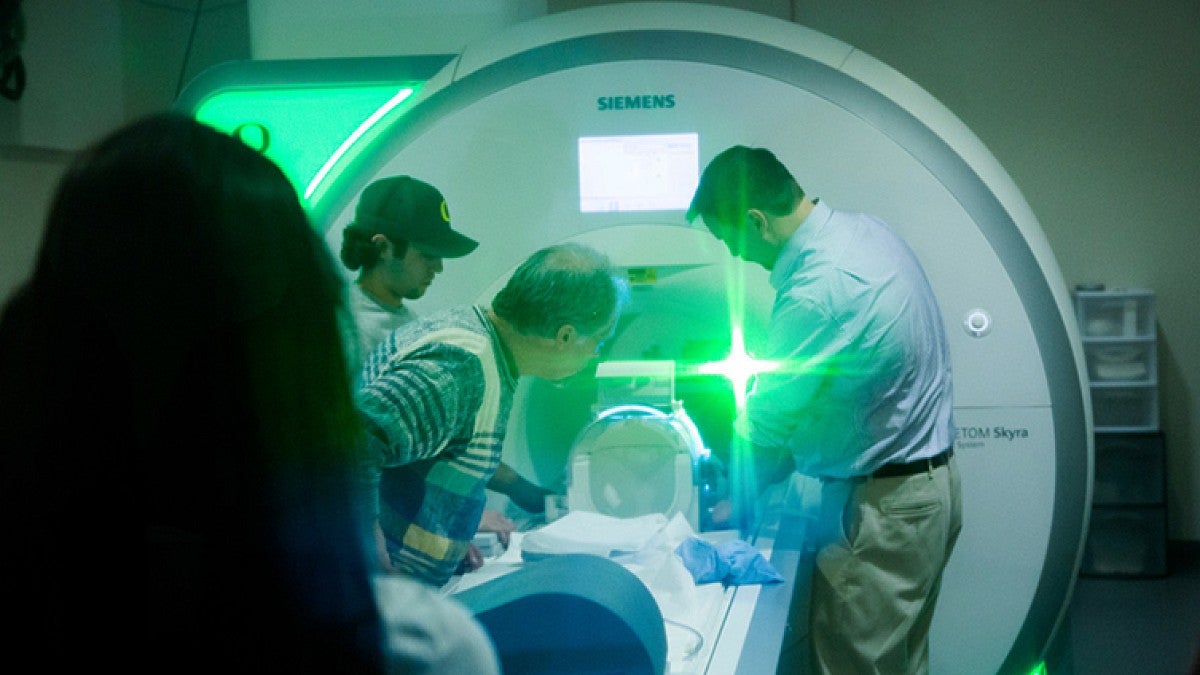In the brains of elementary school children may lie clues for understanding differences in behavior among those with autism spectrum disorder and other developmental delays.
UO researchers Laura Lee McIntyre and Fred Sabb are now using functional magnetic resonance imaging, or fMRI, to find those clues, which, they say, may help plot a roadmap to boost kids’ communication and social skills, and better manage their emotions and behavior.
They've already showed they can use an MRI scanner with 5- to 6-year-olds with disabilities, a group that can be notoriously squirmy. To prepare kids for MRI, they used behavioral protocols, including software developed at Oregon Health & Science University in Portland, to help account for excessive movement.
Now, armed with a two-year exploratory grant from the National Institute of Mental Health, they hope to identify and understand brain differences among children who are developing as expected and those with autism spectrum disorder and developmental delays.
“We will be looking at brain activity when children are at rest, which will help us understand how specific parts of their brain are connected together in brain networks," said McIntyre, a psychologist who heads the Department of Special Education and Clinical Sciences and a researcher in the Prevention Science Institute.
If all goes according to plan, McIntyre said, the project's scope could quickly expand.
"We are interested in how children are doing in school, how their communication is developing, their risk for problem behaviors and their day-to-day functioning and coping skills," she said. "Maybe there are differences in brain network connectivity that will differentiate who will have more impairments. Knowing that could be important. It would help us tailor early interventions to target specific symptoms."
Up to 120 children with autism spectrum disorders and other developmental delays, along with 24 typically developing kids, will undergo scanning in the Robert and Beverly Lewis Center for Neuroimaging and receive neuropsychological assessments.
The project builds on data McIntyre collected in previous research that centered on intervention strategies for affected children, families and schools. Many of the children, drawn from local special education programs and now in the targeted age group, are expected to be included in the study.
One of those studies, the Oregon Parent Project that began in 2011 with funding from the National Institute of Child Health and Human Development, explored the behavior of children with early developmental delay and the well-being of their families during preschool years and the transition into kindergarten. The other study focused on children, age 2-5, with just-diagnosed autism spectrum disorder and the barriers faced by families to obtain evidenced-based clinical services in rural and urban areas of Oregon.
A goal will be to map that previous data into what is found in the new study.
"We have wonderful samples of children that I've been following for a number of years," McIntyre said. "We'd like to draw a subsample of these two earlier studies, collect new data and look at clinical outcomes in early adolescence. We are interested in broadening the scope of our assessments to include brain, behavior and genetics. This exploratory grant gives us a great opportunity."
Data collected in the study — funded under a National Institutes of Health program in which fewer than 10 percent of proposals are approved — will establish a baseline of information for comparisons with normal development in children in future research.
Additional funding is being sought to eventually move the exploratory study into a larger project that will expand the collaborations with OHSU scientists studying autism and the genetics of autism spectrum disorders and developmental delays.
McIntyre and Sabb, director of the Lewis Center, are getting technical expertise from Damien Fair, a neuroscientist at OHSU who heads the Fair Neuroimaging Lab. Fair has pioneered methods to track and filter out unwanted motion recorded during scanning.
In preparation for the new study, McIntyre and Sabb worked with Fair on a proof-of-concept study with 22 children.
"The UO was an early adopter in the use of our software," Fair said. "Their early work really helped us refine our product for use with children."
Fair received a Presidential Early Career Award for Scientists and Engineers in 2013 in recognition of his brain-mapping of childhood development, especially on children with attention deficit hyperactivity disorder and autism. His program, Framewise Integrated Real-time MRI Monitoring, allows scientists to rapidly evaluate data.
Data corrupted by movement results in effects similar to blurring in a photograph. In fMRI data, Fair said, it may suggest brain activity that isn't really occurring. The software also lets users reduce costs by knowing immediately if they've captured enough quality data or need to extend a scanning session.
The work with OHSU reflects a move toward greater collaborative research between the two institutions that will benefit Oregon and the nation.
"Growing our relationship is positive for both institutions," she said. "This project really gives us an opportunity to do something together that we might not be able to get done on our own."
—By Jim Barlow, University Communications


